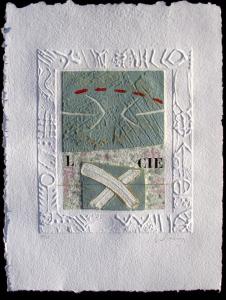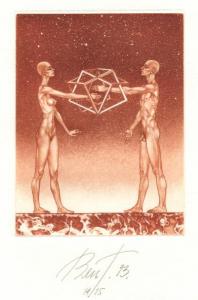An explanation of art techniques and art movements provided by Bestnetart Artgallery
Bestnetart Artgallery provides you with a comprehensive dictionary of all the art terminology you need to know.
Enjoy!
Bestnetart Artgallery is an Artgallery specializing in small size limited edition art-prints by contemporary artists from all around the world. We have art from more than 20 countries and cultures spanning from Hawaii and Nepal to Mexico and many countries in Europe.
Art techniques:
Some art prints have “codes” marked in the prints indicating the technique used
Intaglio printing techniques
c = intaglio printing (blank); c1 = steel engraving; c2 = copper engraving; c3 = etching; c4 = drypoint; c5 = aquatint; c6 = soft-ground etching; c7 = mezzotint.
Relief printing techniques
x = relief printing; x1 = woodcut; x2 = wood engraving; x3 = linocut; x4 = lead engraving; x5 = zinc engraving; x6 = plastic engraving; t = typographic.
Flatbed and industrial techniques
l = lithography; s1 = silkscreen; s2 = mimeography (dye stencil); s3 = katazome; s4 = kappa; p = photographic reproduction, - pi = line block; p2 = half-tone; p3 = photogravure; p4 = rotogravure; p5 = collotype; p6 = photolithography; p7 = offset; p8 = photograph; cad = computer aided design; mt = mixed technique; ut = unregistered technique.
Number preceding the technique = number of plates used; / number after the technique - number of colors used. / col. = hand coloured
Art movements:
Abstract art
Art which is either completely non-representational, or which converts forms observed in reality into patterns which are read / interpreted by the spectator.
Abstract expressionism
Abstract style originating in the U.S. in the 1940's emphasizing spontaneity and energy.
Art deco
Style in decoration and architecture originating in the 1920's characterized by streamlined, rhythmic patterns.
Baroque art
Term coined by the 19th century art historians for the prevailing style in Western European art c. 1580 - early 18th c.
Biedermeier
Art term used to describe the Central European decorative arts of the period 1820-40.
Constructivism
An abstract art movement which manifested itself in Russia shortly before the Revolution.
Cubism
Style inaugurated by Picasso and Braque in the early 20th century featuring fragmentation and rearrangement of natural forms.
Dadaism
Movement originating during and after World War I emphasizing the incongruous and accidental and mocking established traditions in art.
Expressionism
Style developed in Germany in the 1920's stressing the artist's emotional response to the subject, frequently using strong colors and distorted form.
Fauvinism (Fr. Fauve = "Wild beast"; pron. FOHV-ism)
An early 20th century French style employing thick outlines and bold, often clashing, colors unrelated to the colors of its subject in nature.
Gothic art
Medieval art from the mid of the Romanesque period (mid 12th c.) to the beginning of the Renaissance (early 15th c.).
Impressionism
French 19th c. art movement whereby artists tried to catch a particular fleeting impression of color and light rather than making a synthesis in a studio.
Minimalism
Style emerging in the mid-20th century in which the elements are the simplest possible forms.
Naive art
The work of 20th century painters with a European cultural background who have not received a professional training.
Narrative painting
Painting whose chief intention is to tell a story.
Old Master
A painting of high quality produced before 1800 (formerly used for paintings earlier than 1700).
Op art
Name coined in 1947 for a style popular in the 1970's employing optical illusions by juxtapointing color and line in geometric patterns that seem to vibrate.
Pointillism
Late 19-century French style using small dots of pure color to compose images.
Pop art
American style of the 1960's employing imagery from popular and commercial culture to satirize or give emblematic value to familiar objects.
Rococo
A lighter and more playful version of the Baroque, associated with the reign of Louis XV of France.
Super Realism
Same as Photo and Hyper Realism. Exact copying of a photo or object. Often associated with the US on the 1970's.
Surrealism
Style using imaginary from dreams and the subconscious, often distorting forms of ordinary objects or placing them in new contexts.
Transitional art
Work produced by modern African artists re-using discarded European materials.
Trompe l'oeil (Fr. "Fool the eye"; pron. tromloy)
Style in painting so naturalistic that the eye is deceived into seeing flat surface as three-dimensional.
Lovely and varied art is available at www.bestnetart.com wherever you are. The art is delivered unframed for easy and safe delivery. Art prints are very affordable and a great addition to any home. Enclosed pictures in different techniques of artwork by Alain Soucasse, Gennady Vial and Elizabeth Tyler
With compliments
Bestnetart Artgallery
www.bestnetart.com
Magnus Segercrantz
Bestnetart Artgallery
+358 46 8504045
email us here
Visit us on social media:
Facebook
Legal Disclaimer:
EIN Presswire provides this news content "as is" without warranty of any kind. We do not accept any responsibility or liability for the accuracy, content, images, videos, licenses, completeness, legality, or reliability of the information contained in this article. If you have any complaints or copyright issues related to this article, kindly contact the author above.



